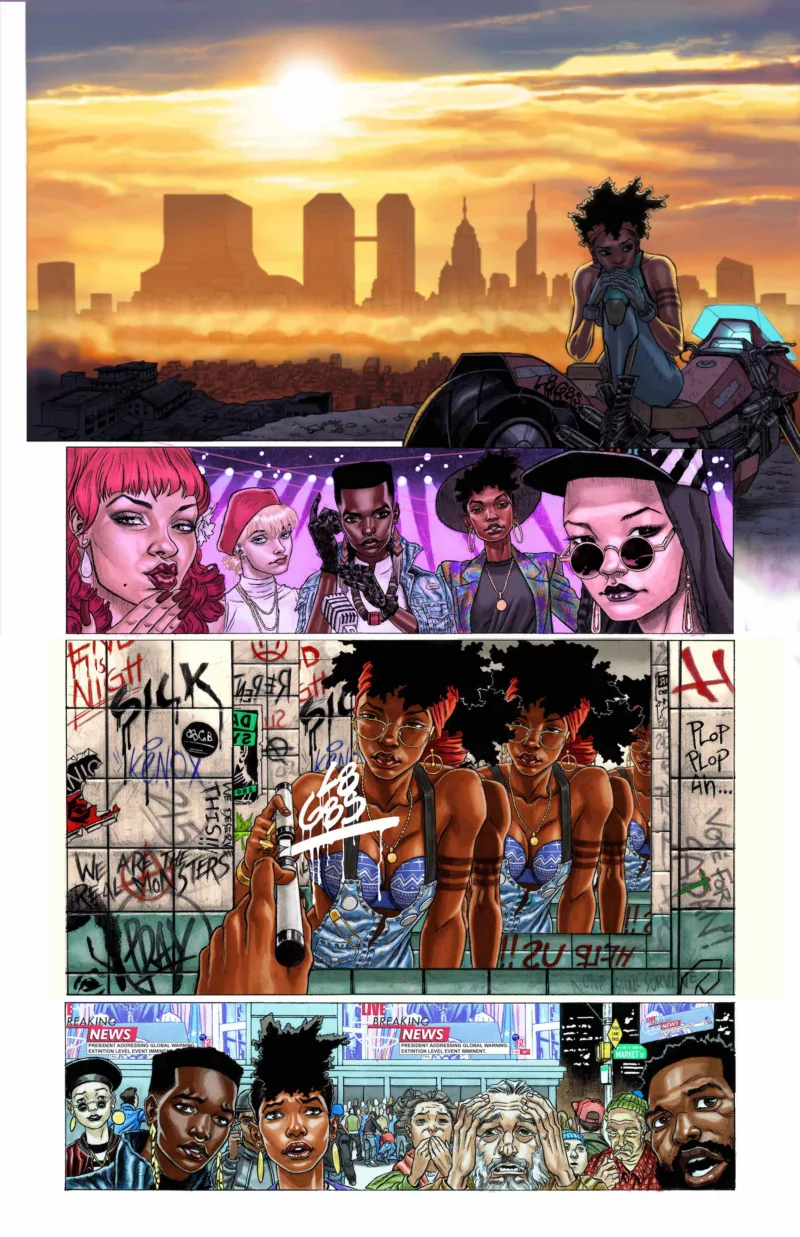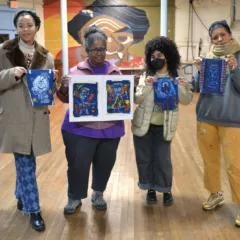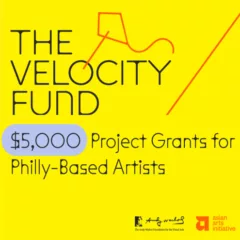Author’s preface
I was honored to interview two of the 2022 awardees for this this story — Li Sumpter (“Illadelph Dreams: 2045”) and Melissa Langer (“In Excess”).Two additional awardees will be featured in an upcoming post later this month – Amelia Carter (“Spirit on 52nd St.”), and Shannon Brooks (“UNDUE BURDEN”).
I love talking with Velocity Fund awardees. They are visionaries and collaborative, and passionate about their projects and about Philadelphia, its people, its quirks and beauties. Whether they are documenting trash problems of our city or creating an immersive Afro-Futurist theatrical event these are artists you want to know, doing projects that deserve support and audiences. They are veritable community projects, made with collaboration and energy. I didn’t ask the artists if they considered themselves optimists, but after interacting with them, via email and phone, I understand the generosity of their projects, which are filled with positivity, energy and hope. Philadelphia needs such generous, positive and hopeful artists and their projects now more than ever as the arts community re-goups and moves forward after the pandemic.
Below are the interviews, lightly edited. I look forward to seeing these projects evolve and grow.

Li Sumpter – Illadelph Dreams: 2045
Illadelph Dreams: 2045 is a multimedia immersive theater production that reimagines the world of the sci-fi classic film Blade Runner through an afrofuturistic, BIPOC perspective. More here
Roberta Fallon: Did your project exist before you applied to Velocity Fund?
Li Sumpter: Yes, it did. Well, the story behind the project did. Illadelph Dreams is another chapter in Graffiti in the Grass, an original afro-apocalyptic myth set in near future Philadelphia inspired by my favorite speculative writing and sci-fi films. It’s an epic tale of personal and planetary transformation that’s been slowly unfolding in my mind and coming to reality in different ways through my multidisciplinary practice. Illadelph Dreams is the next phase in building the world of this larger immersive, transmedia narrative.
Roberta: Does your project have a completion-date or do you envision it as ongoing?
Li: We have dates projected for completion. But “best laid plans” as they say. This will be the largest scale project I’ve created and produced to-date so I’m constantly learning, adjusting, and adapting along the way — and this includes deadlines. Time is a funny thing these days and we are still living through the pandemic and its impact. One thing I’ve learned is it’s super important to give my collaborators and myself grace. Patience with the process is a part of that. I would love to have at least one of three acts of the Illadelph Dreams immersive theater production ready for presentation by Fall 2024. If all goes well, we’re setting our sights on a debut at the Fringe.
Roberta: How does the Velocity Fund help you move your project forward?
Li: The Velocity Fund was a catalyst opportunity for this project. The idea for realizing a chapter of Graffiti in the Grass for the theater stage had been hovering in my imagination for quite a while. As a multidisciplinary artist, you can face challenges with applying for grants and residencies that often require that you choose one or two disciplines of focus. Selecting which work samples to submit can be a nightmare and feels even unfair at times. I’m not sure if it’s the same for other multidisciplinary artists, but as a mythmaker, it takes many moving parts and creative expressions to build the worlds I imagine. For me, all my projects are connected by the Graffiti in the Grass narrative and the “art of survival” ethos. When only one or two parts are used to represent the whole, the complete artistic vision isn’t clear. The vision of your work can be compromised, and your practice can be misunderstood. What really drew me to apply for The Velocity Fund was their open embrace of experimentation, the encouragement to collaborate in new spaces and across genres, and the focus on engaging community in the process.
Roberta: Is the $5,000 from Velocity Fund enough to fund your project?
Li: The Velocity Fund was pivotal because it validated the potential for this experimental project to have wings. Working on a theater production is much like working on a film. It takes a village to make the vision a reality. There’s also the immersive element of this project that involves interactive media and technology — a separate channel of production and expenses! The $5K from Velocity was a powerful first step towards my pursuit of additional funding, partnerships, and residency opportunities that would support the pre-production of Illadelph financially as well as through resources and a growing creative network. Currently, the pre-production of this project is being supported by the Leeway x IPMF Media Artist + Activist Residency, The Village of Arts and Humanities Afrofuturist Residency, RAIR Philly and the Bertha Foundation Artivist Award.
Roberta: What’s your role in the project? And who is helping with the work?
Li: I’m the creator of the transmedia narrative Graffiti in the Grass and the writer/co-director/producer of Illadelph Dreams. Collaboration is the driving force of my practice and what ultimately shapes the outcome of any given project, workshop, or event. My lead collaborators on the theater elements are my frequent partners in creation, Theatre in the X. I also have John Morrison, M. Asli Dukan (2021 Velocity Fund Grantee), Caitlin Green, Luz Emma Cañas, Andrea Walls (2021 Velocity Fund Grantee), Ken McFarlane, Anthony Carlos Molden, Coby Kennedy, Rashid Zakat (2020 Velocity Fund Grantee), Sham-e-Ali Nayeem, and Phil Asbury supporting various other aspects of community engagement and production. From cinematography and sound design, media collage and choreography, gaming design and installations, workshops and events, Illadelph Dreams needs a gang of hands on deck. And this crew keeps getting bigger! But I must say, having the consistent weekly support of Tanner Hicks, my lead Production Assistant for MythMedia Studios, has been priceless.
Roberta: What’s the best possible outcome of your project?
Li: That’s a tricky question because I truly feel the best part of the project is what happens in the process of creating and creatively problem solving in collaboration with others. With highly collaborative, experimental, multidisciplinary art, the outcome is often a surprise, even to those engaged with the work. I think as an educator and a mythologist, it’s always been my practice to lean into the value of the journey itself. I try to check in with myself along the way. How has working on this project deepened my understanding of why I chose this creative path? What has this project taught me and shown me about myself? What new tools and productive relationships will I take with me to the next project? But apart from this, one outcome I would also love to see is Illadelph Dreams fully realized as a multimedia immersive experience for the theater stage. I want this to be a mythic and memorable experience that shines a light on the art of survival and the urgent existential issues of our time.
Roberta: When did you know you were an artist? And how has your art developed?
Li: I’ve been a creative spirit for as long as I can remember. Thanks to my father, Phil Sumpter, art was a part of my life from the day I was born. He was and still is a practicing artist and he taught art at high schools in Philly including the High School of Creative and Performing Arts. My dad had a studio in our basement. I remember quietly sitting on the steps in my PJs, hovering above his drafting table just watching him draw and design for hours on end. I always excelled in my own art classes in elementary and high school, but I’ve never had formal training in any discipline. After undergrad at Spelman College, I decided to pursue a master’s in Arts and Humanities Education at NYU. After graduation, I worked in the museum field in New York for over a decade. All my adult life, I’ve been surrounded by artists and creatives fully immersed in their respective practices. Artists have always been my community. After many years of teaching art, curating programs, and producing projects for other artists — which I loved — I still felt something was missing.
It wasn’t until I was a doctoral student in LA and returned to Philly in 2010 to write my dissertation, Apocalyptic Soul: Seeing Through Image in the Age of End Time, that I realized I desperately needed a creative outlet for my research. As an experienced art educator, I knew about the transformative power art had in the classroom and communities. I knew I had to find a way to put my academic theories around apocalypse into creative and social practice or I might just lose myself in all that darkness. From there, the art of survival and the “escape artist” became the ethos and identity I claimed as my own.

Melissa Langer – In Excess – In Excess traces Philadelphia’s protracted efforts to curb illegal dumping and littering through a series of vignettes about excess, neglect, and human behavior. More here
Roberta: Did your project exist before you applied to Velocity Fund?
Melissa: Melissa: Yes. I’ve been researching and thinking about this project for a number of years. In Excess was born from observation and nurtured by my involvement in an experimental art space in Philly. I make work that studies a phenomenon rather than a single story arc, and that prioritizes networked conceptual and thematic frameworks. I was initially drawn to this topic because it seemed like a strange and uniquely human phenomenon. We’re often encouraged to think about the state of our environment through the lens of individual behavior —- it’s a narrative of personal responsibility that suits big corporations that make disposable materials. But the problem is much more complex, and the content and style of the film reflects that.
I work professionally as a cinematographer, and am often shooting in another city with a limited number of days to capture images. I really wanted to make a film in my own city, so that the filmmaking process had room to breathe and reorient as my relationship with participants and themes evolved – it’s a project that can only work by resisting the culture of urgency around creative production.
Roberta: How does the Velocity Fund help you move your project forward?
Melissa: The grant from The Velocity Fund has been a really important step in moving this project forward – it allowed me to pay for digitizing archival material from Temple’s Special Collections, which is a primary repository of local news footage in the city, and also bring a local Archival Producer onto the team named Caitlin Riggsbee. When I’m filming I work mostly by myself, but I was also able to hire a local cinematographer and sound mixer to help me document some larger events related to trash in the city, as well as pay some close collaborators for their time as they supported me in shaping the vision for the final film.
Roberta: Is the $5,000 from Velocity Fund enough to fund your project?
Melissa: In Excess is the most conceptually and formally challenging work I’ve ever tackled, and the most resource intensive. It’s really hard to get a film project off the ground without early support and funding, and the $5,000 from Velocity Fund was incredibly important for me to be able to start to build a core team of collaborators. Beyond the financial support, the grant also gave me the encouragement and confidence to say to myself, yes, this is an idea that continues to resonate with people in the community. So often we work on creative projects in isolation, but having the support of local organizations like The Velocity Fund is sort of a gut check, a reminder that you’re still making work that’s resonant when the creative process can feel really hard. I’m actively seeking funds and applying for grants to help cover the remainder of the budget.
Roberta: What’s your role in the project? And who is helping?
Melissa: I’m the Director, Cinematographer, and currently Editor on the film. I’m also working with Caitlin Riggsbee, a local Archival Producer, and Nora Wilkinson, a non-fiction researcher and Producer. I’m also grateful to be working with Li Sumpter, another Velocity Fund Grantee, who has been a Creative Advisor on the project since the development phase and continues to help me shape the core vision of the film.
Roberta: What’s the best possible outcome of your project?
Melissa: I’m working towards the completion of a feature-length, non-fiction film. A film isn’t going to solve the trash crisis in Philly, but my hope is that it will add nuance to what’s become a pretty polarizing civic conversation and expose people to ideas that were new to me when I set out to make this film — ideas like extended producer responsibility (where corporations are responsible for minimizing life-cycle environmental impacts of their products), circular economies, etc. Philadelphia isn’t the only city currently dealing with unmanageable amounts of trash — every town, city, and community is responsible for managing waste, and the proliferation of disposable materials, especially plastics, makes this an increasingly difficult task. Philly’s ecosystem echoes broader themes in the country about what’s gained, lost, and wasted in the rush towards power and efficiency.
Roberta: When did you know you were an artist? Talk about that realization a little, and how you got to where you are with your art today.
Melissa: I’ve identified as a filmmaker for years, but I never had a realization per se when I began calling myself an artist… for me it was something I grew into (more than having always had this innate sense). Growing up, I didn’t have a close example of how to live a creative life. Philly has been a place that’s really helped me realize a more expansive sense of self — and becoming a member of Vox Populi has really nurtured my creative practice and growth as an artist.
Roberta: Your project is a community project. Talk about your community.
Melissa: I feel like community is always shifting and expanding for me. But the community around this project includes other artists and collaborators in Philly, specifically other artists of the experimental film and video art community here, along with individuals and organizations participating in the film. The first phase of the film was a 3-channel video installation of archival vignettes of bizarre chapters in Philadelphia’s history with trash at Vox Populi, and recently was part of the 20/92 Video Festival at Icebox Project Space. These installations were a necessary first phase of this feature film, allowing me to workshop ideas, take risks, and integrate creative critique from collaborators and a local audience.
My community in Philly has definitely expanded as a result of making this work and filming across the city. There is a real sense of solidarity when you work alongside others on an issue like this one — one that sometimes gets pushed to the periphery. So there is this felt sense of community, but it doesn’t mean that my reality in terms of this issue looks the same as everyone else’s.
Philly really is a city of neighborhoods, and each neighborhood is affected by littering and illegal dumping to a different degree. When I began making this film, my central question wasn’t about race. And yet, very quickly it was clear that, like most phenomena in America, structural racism plays a huge role in understanding the trash crisis in Philly. If you live in predominantly white parts of the city, like Center City, you might not even know there’s a crisis. I live in West Philly, and though we deal with it here, I don’t have, for example, an illegal dumping “hot spot” on the other side of my block. So it’s not so simple to quantify or talk about a community with a shared experience in relation to this work, because even if we were all working together and towards a similar goal, it doesn’t cost us the same things.
The Velocity Festival – May 9!
Join us for the second year of the Velocity Festival, to celebrate the 2022 Velocity Fund Grantees with a night of art, music, performance, and tasty bites.
Tuesday, May 9, 2023
6–8PM
The Open Kitchen Sculpture Garden
2241 N Philip St
Free and open to all — Register at EventbritePerformances by Sanchel Brown (2021 Grantee) and Anito Gavino (2020 Grantee)
DJ set by Rashid Zakat (2020 Grantee)
Light installation by Alumbra (2020 Velocity Fund Grantee, 2021 Added Velocity Grantee)
Hosted by Pedro Ospina (2020 Grantee) at his Open Kitchen Sculpture Garden
Printed matter by Many Folds Press (2019 Velocity Fund Grantee, 2020 Added Velocity Grantee). AV support from Television, founded by Tim Belknap (2018 Grantee), Logan Cryer (2022 Grantee), and Heidi Ratanavanich (2019 Velocity Fund Grantee, 2020 Added Velocity Grantee).Enjoy a savory and sweet spread of spring treats by DreamWorld Bakes, and free drinks mixed by Art in the Age (while supplies last)!
HOW TO APPLY TO THE VELOCITY FUND FOR 2023–2024 PROJECTS
Philadelphia artists, if you are working on an experimental project in the community or have a growing idea for one, this application is for you. The application is straightforward and if you have questions, there are public Info Sessions or you can request an appointment to talk with TVF’s Project Manager about your project. Apply now and up to midnight June 6, 2023.
Information and links
Applications Due: June 6, 2023 at 11:59PM.
Application
Info Sessions – MAY 18, MAY 23, MAY 30 – REGISTER
One-on-one applicant support by appointment — email velocity@philadelphiacontemporary.org The Velocity Fund Website
FAQ here
From the Velocity Fund Website
Chosen from a diverse field of over 155 applicants, 2022 Velocity Fund Grantees proposed a wide range of projects — including a digital community archive by Disabled people, public sculptures exploring Philadelphia’s radical Queer past, a performance art work at a recycling facility, a video synthesis workshop series, an immersive theater production, a collaboration with high school students, a storytelling project about Philadelphia’s local fish, an experimental short documentary on the historic Black business corridor in West Philadelphia.
What these projects share is a deep connection to communities throughout Philadelphia, forefronting visual art as a means to address complex histories and critical realities with an emphasis on collaboration and feedback.
The 2022 Velocity Fund grantees in alphabetical order:
Shannon Brooks, UNDUE BURDEN
Amelia Carter, Spirit on 52nd St
Maia Chao, Waste Scenes
Logan Cryer, Invited: Take Care of the Square Footage
Stephen Foster, The Eyes Beneath the Oak
Nicolo Gentile, Tough Love
Sound Museum Collective, Cathode Ray Tapestries: Memory, Nostalgia & Analog Video Synthesis
Melissa Langer, In Excess
Gilletta McGraw, Black In The Days: A Community Building, Multidisciplinary, Interactive Memoir
Li Sumpter, Illadelph Dreams: 2045
Mat Tomezsko, Revolutionary Philadelphia
Feini Yin, Our Fishing Log
Established with the support of The Andy Warhol Foundation for the Visual Arts, The Velocity Fund is one of numerous Regional Regranting Programs launched by the Foundation to recognize and support the movement of independently organized, public-facing, artist-centered activity that animates local and regional art scenes but that lies beyond the reach of traditional funding sources. The Velocity Fund is administered by Philadelphia Contemporary.









